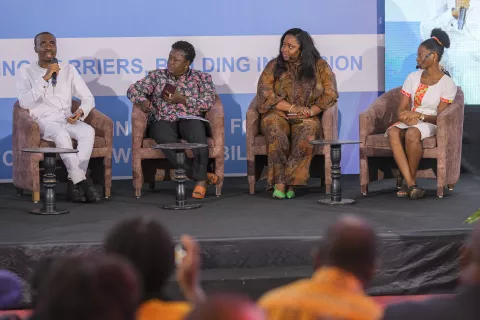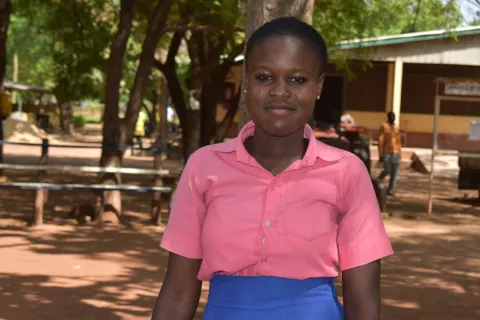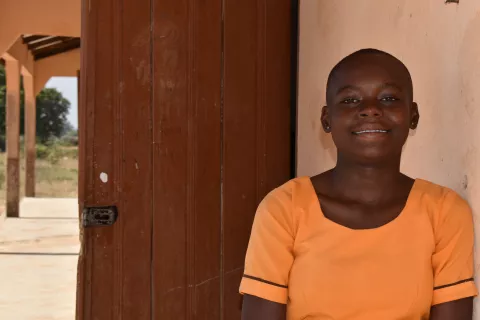Making entrepreneurship opportunities accessible to every young person, no matter their abilities
Young people living with disabilities are often left behind in the social innovation discourse. How is UNICEF working to change this narrative?

A third of Ghana’s population is young – over 10 million, each of them relying on equal and expanded opportunities to education and training, employment, and entrepreneurship opportunities to succeed. Early-stage youth entrepreneurship is rising in Ghana, especially in the informal sector, owing to limited job creation in the formal sector.
UPSHIFT’s focus on using a community-first approach to train young people on social innovation and entrepreneurship is relevant within this context. UNICEF designed four pilots across six regions to test the effectiveness and sustainability of UPSHIFT’s methodology with young people with diverse abilities and backgrounds and stakeholders to better inform meaningful scaling in Ghana.
One such pilot implemented by UNICEF partner, African Health Innovation Centre (AHIC), focused on adapting UPSHIFT to meet the capacity building needs of young people who are deaf and hard-of-hearing. In Ghana, most of the Ghanaians who are hard of hearing, live in low-income communities and face social and economic marginalization. Nationwide, the country’s 14 schools for the deaf aim to provide basic education and vocational training to their students but are under-resourced. The pilot sought to test how UPSHIFT could complement existing resources and school curriculum to effectively reach students, targeting 56 students in two schools for the deaf in Tema and Mampong.
Three key activities were implemented. Firstly, UPSHIFT was introduced to school students, parents, administration and teachers, officials at the Ministry of Education and Ghana Education Service, and the Ghana National Association of the Deaf. Through focus group discussions, potential project challenges and opportunities were assessed and stakeholder buy-in secured. Secondly, Human-Centered Design workshops were used to adapt the UPSHIFT curriculum for sign language, with both teachers and professional interpreters supporting UPSHIFT trainers. Lastly, the adaptation process focused on practical employability training that would help the students internalize their learnings in the real world. Underpinning these activities was a strong emphasis on documenting learnings through qualitative and quantitative methods.
Both anticipated and unanticipated learnings included the following: While the delivery of the curriculum in sign language required a more time-intensive approach and an innovative pedagogy to explain critical concepts, the process had to also develop more image-based teaching methods due to low literacy levels amongst students. Moving forward, the design of the UPSHIFT curriculum will factor in both literacy level and disability.


The quality of speech to sign interpretation by schoolteachers was lower than that by external professionals. Teachers tended to act as gatekeepers of the information that was delivered by the UPSHIFT trainer and repackaged it for students. This increased the risk of mis-learning where teachers did not fully understand the concepts themselves. To better engage teachers as interpreters, the program will require dedicated training sessions on the UPSHIFT curriculum. While using only professional interpreters is an option, the idea could face resistance from schools, since it may impact teacher benefits and minimize their role.
Students overwhelmingly preferred to engage on activities from the UPSHIFT toolkit that supported their entrepreneurship skilling. The choice appeared to stem from a preference to work as independent workers, with limited interaction with those outside the deaf community. On the demand side, businesses engaged by AHIC for job matching also demonstrated limited understanding of how to integrate deaf employees into their operations.
UNICEF and AHIC will continue to unpack learnings from the pilot, with the objective to identify pathways to scale UPSHIFT in Ghana for all young people. The pilot has helped us adapt and test a customized version of the UPSHIFT curriculum, identify schools as a long-term pathway for delivery, identify the incentives that drive behavior by various stakeholders, and begin to understand gaps within the social structures and labor market that the deaf students will engage with when they transition to the workplace. We will validate these analyses with our partners, compare learnings with our other UPSHIFT pilots, and continue to test approaches to work with other disabled groups of young people. With this, UNICEF can support the Government of Ghana and other partners to train young Ghanaians on social innovation and entrepreneurship at scale, especially those who are disabled and disadvantaged. Thus, leaving no one behind.




